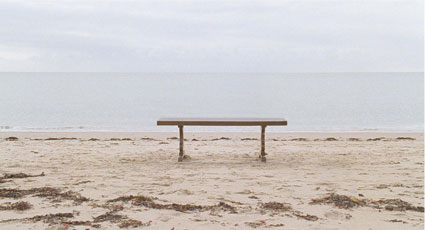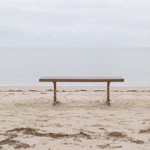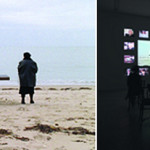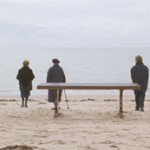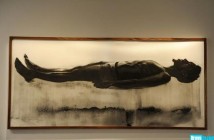AGNÈS VARDA: LES VEUVES DE NOIRMOUTIER @ THE SERT GALLERY, CARPENTER CENTER FOR THE VISUAL ARTS
The feeling is one of acute sadness. You enter into the gallery and are confronted by fifteen images, one large projection surrounded by 14 small monitors. The center image is of a large table on a beach. It is the kind of table that one sees in an old farmhouse. It is heavy and worn. The ocean is a flat, grey expanse stretching away behind it. Slowly women begin emerging from off screen. They are all dressed in black and grey. First there is one and then two, eventually there is just under a dozen women wandering the space of the table and the beach. They begin circling the table. Some are running their hands along and across its surface. The only sounds are the waves lapping the shore and the cries of seabirds. It is moving and heart wrenching despite the fact that at first glance it seems as though this is simply a melancholic examination of aging and mortality. What brings the piece to a whole different level are the fourteen monitors that surround the main video.
Each of the monitors tells the story of a woman in this town, Noirmoutier in the far west of France, who has been widowed. A corresponding chair is placed in the gallery with headphones and a card transcribing the dialogue of the videos (they are all in French). What seems to be a purely practical maneuver is actually a clever device to bring the viewer into intimate contact with each woman as they tell their story. The stories range from the concise to the deep. You see each of these women examining their lives and what it means when their husband is gone. There is much that resonates with New England life. Noirmoutier is a small island where life centers on fishing. Each of these women and their husbands had a deep and lasting relationship with the sea. I felt that in many ways it is similar to life in Gloucester or many other New England towns that rely on the sea for survival. Although not all of the women were widowed by the sea, it seems that the ocean and fishing play a large role in their lives.
Agnès Varda is one of the most renowned filmmakers living today. She is a photographer, filmmaker and installation artist. She has been making films since the nineteen fifties and is thought of in the same category as Chris Marker, Marguerite Duras and Alain Resnais. Her films are known for their documentary qualities (interestingly her first film La Pointe-Courte (1955) takes place in a small fishing village) and she recently received the Cesar Award (the National Film Award of France) for her documentary The Beaches of Agnès. It is hard to watch and experience this piece without sensing the presence of Varda. Varda is herself a widow, her husband, the famous director Jacques Demy, died of leukemia in 1990. While he was ill the two of them collaborated on an autobiographical film titled Jacques de Nantes, which was completed shortly after his death. It is Varda’s intimate relationship with mourning that suffuses this piece with such power. Varda understands the loss and the relationships these women have to men who are gone.
These women share their stories with her (and obviously with us). She questions and occasionally prods them. Some talk haltingly while others tell their stories in such detail you wonder how long they have kept them bottled up. You get the sense that Varda is telling her story through these women. They survive and carry on, navigating a social space that oftentimes leaves little room for them. One woman, whose husband committed suicide, believes that the town blames her for it. Another woman has taken over her husband’s position on their bed. Each of these women presents another side to loss and mourning. It is quite compelling. Ultimately the installation almost functions like two distinct pieces. Both resonate and carry deep meaning. However, the manner in which it was presented left me wanting more of a connection between the two. Perhaps it was the headphones and the seats. I felt as if I was leaving each narrative and moving on to the next.
Perhaps Varda wants us to build the story in our heads as we navigate the room? You pick up one piece here and the next over there, each leading to a fuller, deeper resolution of the work. Is there another, possibly better way to experience and install this piece? I like the idea of the cacophony of voices filling up the room but that would eliminate the intimacy of each woman’s story. I’m torn between wanting the piece to be one way and accepting the way it is. Regardless of my desires for the piece it is truly powerful and worth experiencing. Who hasn’t experienced loss? Varda’s installation gives us the opportunity to sit with it and watch how these women deal with the unexpected death of a partner. It is a worthwhile experience.
- Agnès Varda, from Cinq photographies de veuves, 2005. Suite of five digital photographs from 35 mm negative.
- Agnès Varda, Les Veuves de Noirmoutier (The Widows of Noirmoutier), Video, 2004, Installation View.
- Agnès Varda, Les Veuves de Noirmoutier (The Widows of Noirmoutier), Video, 2004
"Agnès Varda: Les Veuves de Noirmoutier (The Widows of Noirmoutier)" is on view March 12 - April 12, 2009 at The Sert Gallery at the Carpenter Center for the Visual Arts at Harvard University.
All images are courtesy of the artist and the Sert Gallery.

